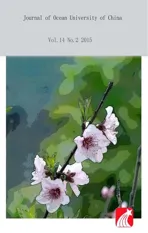Composition and Origin of Ferromanganese Crusts from Equatorial Western Pacific Seamounts
2015-04-05WANGGuozhiJANSALubaCHUFengyouZOUCanandSUNGuosheng
WANG Guozhi, JANSA Luba, CHU Fengyou, ZOU Can, and SUN Guosheng
1)State Key Laboratory of Oil and Gas Reservoir Geology and Exploitation,Chengdu University of Technology,Chengdu610059,P. R. China
2)Department of Earth Sciences,Dalhousie University,Halifax, N.S., B3H 4R2,Canada
3)Key Laboratory for Geosciences,State Oceanic Administration,Hangzhou310012,P. R. China
4)Chengdu University of Technology,Chengdu610059,P. R. China
5)College of Earth Sciences,Jilin University,Changchun130026,P. R. China
Composition and Origin of Ferromanganese Crusts from Equatorial Western Pacific Seamounts
WANG Guozhi1),*, JANSA Luba2), CHU Fengyou3), ZOU Can4), and SUN Guosheng5)
1)State Key Laboratory of Oil and Gas Reservoir Geology and Exploitation,Chengdu University of Technology,Chengdu610059,P. R. China
2)Department of Earth Sciences,Dalhousie University,Halifax, N.S., B3H 4R2,Canada
3)Key Laboratory for Geosciences,State Oceanic Administration,Hangzhou310012,P. R. China
4)Chengdu University of Technology,Chengdu610059,P. R. China
5)College of Earth Sciences,Jilin University,Changchun130026,P. R. China
In the equatorial western Pacific, iron-manganese oxyhydroxide crusts (Fe-Mn crusts) and nodules form on basaltic seamounts and on the top of drowned carbonate platform guyots that have been swept free of pelagic sediments. To date, the Fe-Mn crusts have been considered to be almost exclusively of abiotic origin. However, it has recently been suggested that these crusts may be a result of biomineralization. Although the Fe-Mn crust textures in the equatorial western Pacific are similar to those constructed by bacteria and algae, and biomarkers also document the existence of bacteria and algae dispersed within the Fe-Mn crusts, the precipitation, accumulation and distribution of elements, such as Fe, Mn, Ni and Co in Fe-Mn crusts are not controlled by microbial activity. Bacteria and algae are only physically incorporated into the crusts when dead plankton settle on the ocean floor and are trapped on the crust surface. Geochemical evidence suggests a hydrogenous origin of Fe-Mn crusts in the equatorial western Pacific, thus verifying a process for Fe-Mn crusts that involves the precipitation of colloidal phases from seawater followed by extensive scavenging of dissolved trace metals into the mineral phase during crust formation.
ferromanganese crusts; biomarker; hydrocarbon; REE; trace element; hydrogenous origin
1 Introduction
Iron-manganese oxyhydroxide crusts, hereafter abbreviated as Fe-Mn crusts, form on the top of seamounts on oceanic ridges and plateaus, and are widespread from 52°N to 47°S in the Pacific Ocean and between 48°-63°S and 90°E-30°W in the subantarctic zone (Bogdanovet al., 1995; Blanckenburget al., 1996; Heinet al., 2000; Rehkämperet al., 2002). Fe-Mn crusts are found in water between 400 and 4000 m depth and to be the thickest between 800 and 2,500 m depth (Bogdanovet al., 1995; Wenet al., 1997; Heinet al., 2003). Laminated crusts are different from hydrogenetic and diagenetic Fe-Mn nodules and are thought to be only of hydrogenetic origin (Halbach, 1986; Odaet al., 2011; Renet al., 2011). Therefore, the elemental composition of the crusts reflects the composition of seawater rather than pelagic sediments (Quinby-Hunt and Turekian, 1983). Hydrogenetic Fe-Mn crusts grow slowly at rates of approximately 0.55 to 10 mm Myr-1(Bogdanovet al., 1995; Heinet al., 2000). The age of some crusts has been estimated at 70 Ma, and oth-ers are estimated to have formed in the mid-Cretaceous period (Watkinset al., 1995a; Klemmet al., 2005; Wuet al., 2011). Young crusts that were formed in recent times have also been found (Rehkämperet al., 2004). The deposition of crusts is not a continuous process, which was demonstrated in a biostratigraphic study by Watkinset al.(1995b). At least five episodes of manganese growth have been documented in crusts in the western Pacific:one occurred in the period from Late Cretaceous to early Paleocene, and the other four occurred in the Eocene. In addition, other authors later identified five episodes of phosphatization, two of which occurred in the period from Late Cretaceous to early Paleocene and the other three occurred in the latest Eoceneearly Oligocene. The growth of the younger crust generation started in the Miocene and has continued to the present, without interruption by further phosphogenic events (Heinet al., 2000). Crusts record not only changes in the chemical composition of ancient surface and intermediate water masses, but also changes in current regimes (Odaet al., 2011; Gonzálezet al., 2012). The combination of these principle variables results in a very complex textural and compositional signature that is characteristic of the Fe-Mn crusts deposited on the surface of seamounts andguyots in the central Pacific. Bogdanovet al.(1995) demonstrated that the chemical composition of crusts from the northwestern Pacific guyots at about 10°N latitude differs from those located between 27° and 34°N. They also found the crusts of different mineralogical and chemical compositions on a single guyot, which illustrates the complexity of the Fe-Mn oxyhydroxide precipitation process.
In addition to the three principal hypotheses of crust origin-diagenetic, hydrogenetic and hydrothermal (Halbach, 1986), a fourth one, biomineralization, has recently been added (Chenet al., 1997; Hanet al., 1997; Huet al., 2000; Wang and Muller, 2009; Wanget al., 2009; Logeset al., 2012; Polgáriet al., 2012; Lozano and Rossi, 2012). Wang and Muller (2009) presented a hypothesis that coccoliths are crucial for the seed/nucleation phase of crust formation, thereby suggesting biologically induced biomineralization. Morphological features at the top of some crusts are indeed similar to some textures constructed by either algae (stromatolites) or bacteria (deep water thrombolites) (Jansaet al., 1989; Polgáriet al., 2012; Lozano and Rossi, 2012).
To test this hypothesis, Fe-Mn crusts were collected from the equatorial western Pacific between latitude 16°-21°N. Analyses of biomarkers, micro fluorescence, electron probe, and geochemistry were conducted.
2 Methods
The major element geochemistry of samples was measured by X-ray fluorescence spectrometry. Trace elements, such as Cr, Co, Ni, Cu, and Zn, as well as REE concentrations, were measured by inductively coupled plasmamass spectroscopy (ICP-MS) at the Institute of Geochemistry, Chinese Academy of Science; the analytical accuracy was better than 4%. The wet bulk density was determined according to the weight and volume of wet crust samples. Textural compositions and microphotograph of back-scattered images in the crust were examined at the Analytical Center of Chengdu Geological Mineral Institute using a high-resolution electron probe (JCXA-733) with 25 keV accelerating voltage and (2.0-2.5)×10-8A beam current.
Hydrocarbons from organic matter and types of microbes in the crust were studied by fluorescence and biomarker analyses. The fluorescence study was conducted using a fluorescence microscope in the Organic Geochemistry Laboratory at Sinopec Geological Institute in the Shengli Oil and Gas Field. The color filter group for fluorescence microanalysis was composed of an exciter filter, BP400-440λ, a barrier filter, LP470λ and a dichromatic beam splitter, FT460λ. The biomarkers in the Fe-Mn crust were determined using a chromatogrammass spectrograph in the Guangzhou Institute of Geochemistry, Chinese Academy of Science (Huet al., 2002).
3 Samples
Seamounts coated by Fe-Mn crusts are common in the equatorial western Pacific. In this study, crust samples were collected during theR/V Dayang Yihaoresearch cruise (Voyage No. DY105-11). The seamounts investigated are located within the seamount group south of Emperor Ridge, the Mid Pacific Mountains, and the Marshall Islands area. For the study, seven representative Fe-Mn crusts were selected from different seamounts at water depths between 1651 to 3118 m (Table 1). All recovered Fe-Mn crust samples were taken from the CA, CX, CL and ME seamounts of the equatorial western Pacific (Fig.1).
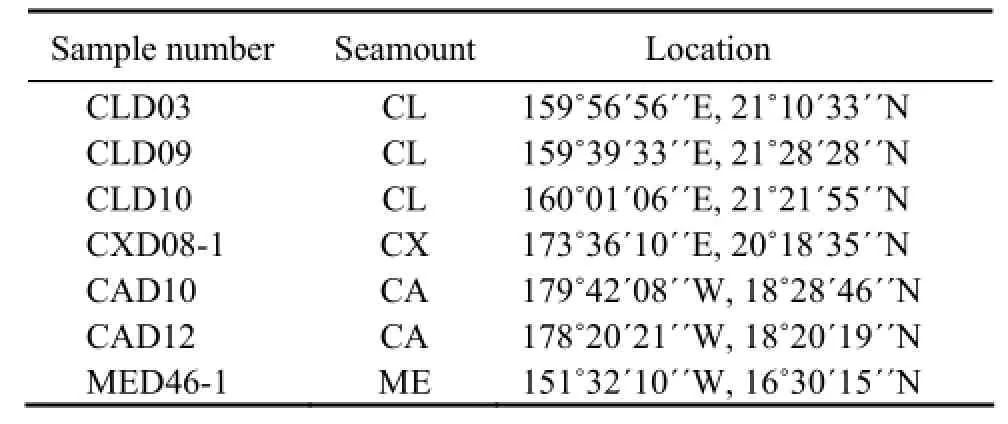
Table 1 Data of samples
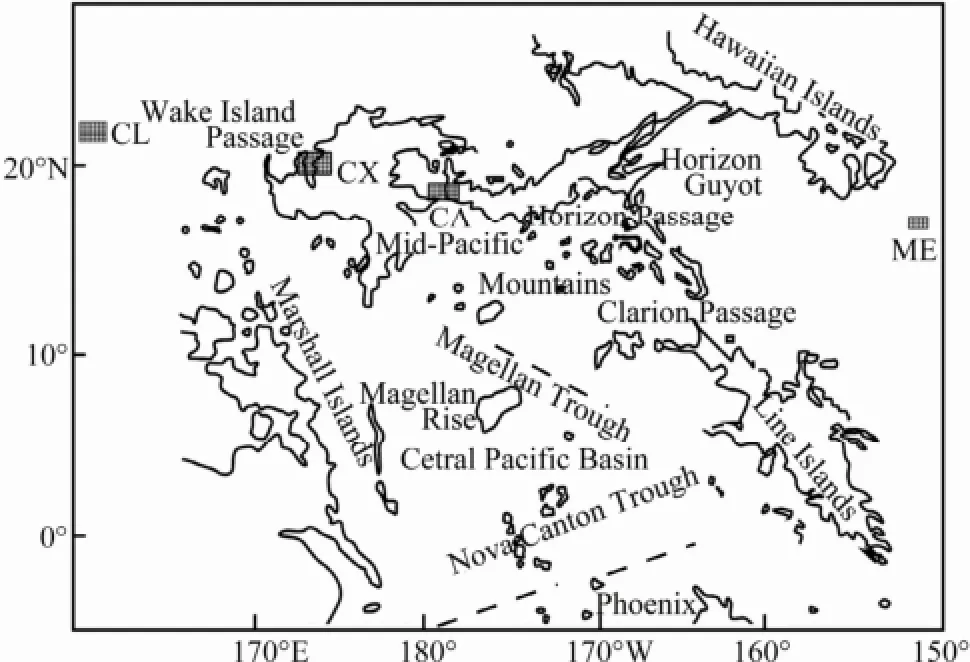
Fig.1 Location map of the study area. CL, CX, CA, ME:seamount name; solid lines: boundaries of islands or seamounts.
4 Results
4.1 Texture and Physical Features
A Fe-Mn crust surface consists of massive, botryoidal, laminated, columnar or mottled textures. The characteristic layering is regionally persistent in the equatorial western Pacific. Two types of Fe-Mn crusts were discovered during theR/V Dayang Yihaoresearch cruise (Voyage No. DY 105-11). The first type is a layered (laminar) Fe-Mn crust, and the second a nodular-shaped crust. The samples related to the first crust type were taken from the CA and CL seamounts (Table 1). All the sheet crust samples had a similar structure consisting of single, double or triple layers, often with a botryoidal surface. The botryoids varied in size from 1 mm to 1 cm, and the surface was knobby. Two different layers were observed in most crusts. In the samples with triple layer structures, the upper and lower layers were dense, and the middle layer was porous and less coherent. Thickness of the crust sheet differed across seamounts and even on the same seamount. Sampledcrusts were 0.3-15 cm thick (Table 2) and did not show an affinity for the underlying substratum that they were coating. The coat bedrock of Fe-Mn crusts also differed in different seamounts. The CA and CX seamounts had bedrocks made of limestone, phosphorite and some volcanic breccia. Crusts from the CL and ME seamounts were underlying basalt, volcanic breccia and some limestones (Table 2). The water depth of the crusts on seamounts ranged from 1651 to 3118 m (Table 2).
Stromatolite-like textures, similar to those found in limestone, can be found in some Fe-Mn nodules and crusts and are widely reported in literature (Zhanget al., 1995; Linet al., 1996; Chenet al., 1997; Hanet al., 1997; Wang and Muller, 2009; Wanget al., 2009; Lozano and Rossi, 2012). Therefore, crusts are either laminated, columnar,branched (palmate), or digitate with visible textural features of different colors (Fig.2a). Fe-Mn crusts also occur in other textures, such as knobby, half knobby, rounded, pellet and botryoidal (Figs.2b, c).
The digitate and columnar textures look like those formed by microbes (Zhanget al., 1995; Bianet al., 1996; Hanet al., 1997; Lozano and Rossi, 2012) or blue green algae and bacteria (Yu, 1988). Sometimes, two or more smaller round grains are stuck together, displaying as an oval pellet or pisolite (Fig.2d), similar to a zoogloea colony of algae (Yu, 1988). The wet density range of the sampled Fe-Mn crusts from different seamounts is close,i.e., 1.64-1.97 g cm-3(Table 2).

Table 2 Characteristics of Fe-Mn crusts and nodules from studied seamounts

Fig.2 Algae-like structure of Fe-Mn crusts. a. Columnar texture, Sample CAD 10, 10×10(-); b. Knobby texture, Sample MDD46-1, 10×20(-); c. Concentric ring-merged rounded ball-like texture, Sample CAD12, 10×20(-); d. Digitate texture, Sample MED46-1, 10×10(-).
4.2 Mineralogical Components
Fe-Mn crusts predominantly consist of manganese phases (vernadite, todarokite, binessite), iron phases (goethite, β-amakinite) and a lesser amount of phyllosilicates (illite, smectite, chlorite), apatite, zeolite, feldsparsand quartz (Zhuet al., 2001; Maet al., 2002; Zhaoet al., 2009). Although the mineralogical components of the manganese phases are different in Fe-Mn crusts taken from different seamounts, vernadite is the main mineral in the manganese phases. The back-scattered images and characteristic X-rays of the Fe-Mn crusts reveal that the manganese phase and the iron phase are alternately distributed (Fig.3).
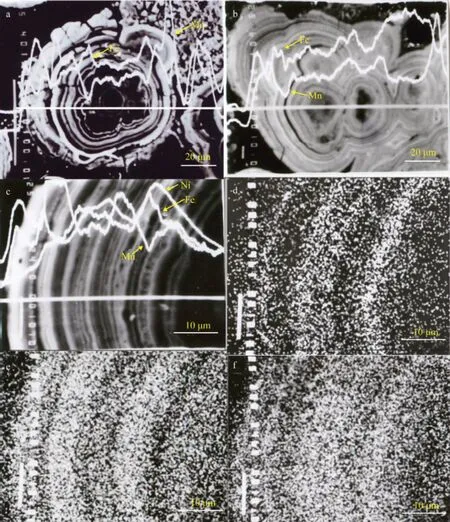
Fig.3 Back-scattered image and characteristic X-ray of a Fe-Mn crust of sample CAD12. a. Concentric ring structure; b. Globular structure; c. Half of concentric ring structure; d. Mn (grey white part) belt distribution; e. Fe (grey white part) belt distribution; f. Area scanning of Ni (grey white part); d, e, f show the same part of a crust sample as c.
4.3 Textural Composition
A line scanning of concentric rings, pelletoid, knobby and stromatolite-like structures was further studied with back-scattered images and characteristic X-rays (Fig.3). The back-scattered images show similar banding that can be observed in lamellar textured crusts under optical microscope. The X-ray area scanning for Fe, Mn, and Ni in the laminar crusts shows that the band distribution, thickness and composition overlap with laminae in backscattered images and under microscope. Fe and Mn have an apparently inverse correlation by X-ray and/or area scanning,i.e., Mn is relatively deficient in iron-rich layers and vice versa (Figs.3a-c). This variability could be an effect of surface water bioproductivity and its influence on the position of the oxydic and suboxic environment boundary and the base of the oxygen minimum zone. The importance of this zone is that Mn does not accumulate in a low oxygen environment. The presence of alternating Fe- and Mn-rich bands indicates a fluctuation in water column composition due to either changes in surface water bioproductivity and the related expansion, contraction of the oxygen minimum zone, or changes in composition of intermediate water masses in the equatorial Pacific and current flows.
There is an uncertainty and controversy about Ni correlation with Fe and Mn occurrences in cobalt-rich crusts (Murray and Brewer, 1977; Duttaet al., 2001). The characteristic X-ray and the area scanning pattern show that Ni is more abundant in the iron-rich phase than in the Mn- rich phase, and that it is relatively deficient in the Mn-rich phase (Figs.3c-f). According to the band composition, the layer dominated by iron is considerably wider than that of Mn, but Ni is represented by the widest band(Figs.3d-f).
4.4 Biomarkers in the Crust
Biomarkers originate from the parental source of an organism and are preserved in rocks and sediments (Moldowanet al., 1985). There is little or no difference between parental materials and biomarkers in the textures of organic molecules due to their relative stability during diagenesis and secondary alterations. As characteristic organic compounds, biomarkers can provide information about the organic composition of the parental materials. Hence, biomarkers preserved in Fe-Mn crusts can provide evidence of organic materials, such as microbes, algae, or other organisms contained in crusts.
Seven representative samples were chosen for the biomarker analysis. All of the results indicated that normal alkane, terpenoid and sterane were the representative biomarkers. The chromatogram-mass spectrum of a representative sample CAD10 is shown in Fig.4.
The gas chromatography results for saturated hydrocarbon show that the carbon number of normal alkane extends between nC15and nC31(Table 3). There are two distribution peaks of normal alkane in all samples except for one peak in sample CLD10. The carbon number of the first main peak is mostly nC17with incidental nC16and nC18, whereas the second main peak is nC23(Fig.4a, Table 3). Isoprenoid alkane shows distinctive phytane dominance (Fig.4a); Pr/Ph and Pr/nC17are 0.27-0.78 and 0.84-1.91, respectively. The Pr/nC17of six samples is higher than 1 and Pr/nC18is 1.23-3.69 (Table 3). The normal alkane in most samples has a doublet form, suggesting that biogenic input may not be dominated by a single organism. Although the distinctive dominance of nC17is often found in algae (Clark and Blumer, 1967; Tissot and Welte, 1984), it can also be found in nonphotosynthetic bacteria living on the ocean floor (Tissot and Welte, 1984). The higher ratio of Pr/nC17(〉1) in most samples also indicates the presence of algae, while the high ratio of Ph/nC18and phytane dominance are indicative of paleobacteria.
The distribution of terpenoid compounds in the saturated hydrocarbon from the Fe-Mn crusts is shown in Fig.4b. C20-C28series of tricyclic diterpene and C27-C33series of pentacyclic triterpane are the dominant biomarkers. The pentacyclic triterpane is composed of hopane, norhopane and homohopane. Compared to pentcyclic triterpane, the tricyclic diterpene is more abundant. The ratio of tricyclic diterpane/hopane is 0.67-1.92. The composition of terpenoid indicates that algae and/or bacteria are present during crust formation. The higher abundance of tricyclic diterpene indicates that algae are the dominant biological component (Volkmanet al., 1989; Huet al., 2002).
The sterane composition of organic matter in ferromanganese crusts is illustrated in Fig.4c. It is mainly composed of regular sterane, which is characterized by higher abundance of pregnane and homopregnane and lower abundance of rearranged sterane. Distinctive 4-methyl sterane mainly composed of nC30compounds is identified inm/z231 mass chromatogram. The regular sterane shows C27〉C28〉C29or C27〉C29〉C28.The regular sterane/17α(H)-hopane values of seven samples are 2.15-2.84. The abundant sterane and high ratio of regulation sterane/17α(H)-hopane (〉1) clearly indicate an early presence of algae (Moldowanet al., 1985; Huet al., 2002). The 4-methyl sterane likely originates from 4-methyl alcohol inDinophyceaeorganisms (Wolffet al., 1986), or from bacteria (Birdet al., 1971).
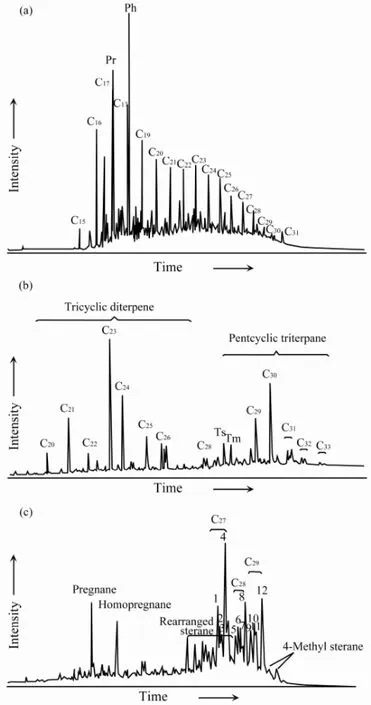
Fig.4 Chromatogram-mass spectrum of saturated hydrocarbon of organic material in Fe-Mn crusts. (a) gas chromatogram spectrum of normal alkane; nC15-nC31:Normal alkane; Pr: Pristane; Ph: Phytane; (b) distribution of terpenoid compound (m/z191); (c) distribution of sterane compound (m/z217); C27-C29: Regular sterane; 1-12 represent isomer of sterane, 1, 5, 9: type of ααα-20S, 2, 6, 10: type of αββ-20R, 3, 7, 11: type of αββ-20S, 4, 8, 12: type of ααα-20R. 4-methyl sterane was identified asm/z217 andm/z231 chromatogrammass spectrums.
Tm/Ts and C31terpane 22S/22 (S+R) are important parameters indicating the maturity of organic matter in bio-marker spectrums. With increasing maturity of organic matter, the ratio of 22S/(22S+22R) increases from 0 to 0.6 (equiponderant state varies from 0.57 to 0.6). A 22S/ (22S+22R) ratio between 0.5 and 0.54 suggests the beginning period of oil-formation. A ratio of less than 0.55 further signifies that oil is formed under extremely low temperature (Peters and Moldowan, 1995). A 22S/(22S+ 22R) ratio between 0.57 and 0.62 indicates that oil is formed, or even exceeded (organic matter becomes over matured). The Tm/Ts of hydrocarbons ratio, the βα-C30hopane/αβ-C30hopane ratio, and the C31terpane 22S/22 (S+R) ratio in the crusts from the study area vary from 0.58 to 1.16, 0.02 to 0.15, and 0.25 to 0.58, respectively. The 22S/(22S+22R) ratios of three samples are less than 0.5, one is between 0.5 and 0.54, and the other three samples are close to the values of 0.57-0.62. All of these data indicate that hydrocarbons present in Fe-Mn crusts are mostly immature, some approaching low maturity.
The compositions of biomarker normal alkanes, terpanes and steranes indicate that algae and bacteria are present during the formation of Fe-Mn crusts in the study area. The presence of the organisms during the Fe-Mn crust formation is further supported by the occurrence of low maturity hydrocarbons in the Fe-Mn crusts.

Table 3 Main parameters of normal alkane in Fe-Mn crusts
4.5 Fluorescence
Microbes and other organisms emit fluorescent light when examined under a fluorescent microscope, whereas most abiotic particles do not. The presence of microbes in Fe-Mn crust samples can be determined using microfluorescent analysis. The results show that during the evolution of organic matter from low-maturity to highmaturity, the fluorescent color generated by hydrocarbons changes from light yellow → brown yellow → brown →dark blue → blue grey → no fluorescence. As mentioned above, many textures of Fe-Mn crusts are very similar to those produced by algae and bacteria (Jansaet al., 1989). If these structures are of algal and/or bacterial origin, or if the algae and/or bacteria were present during crust formation, they would have emitted fluorescence of different colors once the organic matter was transformed into hydrocarbons. If the hydrocarbons have not migrated, the place of fluorescence would indicate the location of the biological precursor; but if they have migrated, an oil migration trace would be left in the crust, and the oil migration path can be tracked by the fluorescence trace.
All samples with concentric rings, pelletoid, knobby, digitate, columnar, and thinly laminated textures (Fig.2) similar to those of microbes were examined, but none of the textures showed any fluorescence under fluorescent microscope. The results strongly indicate that the process of Fe-Mn oxyhydroxide precipitation on the surface of hard rocks in the Pacific Ocean is most unlikely mediated by catalytic processes through bacteria, as suggested by Heinet al.(2000) and Wang and Miller (2009). Cuiet al.(2008) proposed that the microstrata change of light and dark colors of laminae in the columnar structure of cobalt-rich crusts, and the corresponding difference in chemical composition resulted from changes in the micro-redox environment. The branches of the columnar structure and the different growth rates of the same microstrata relate to the double electrode layers in the growing interface of cobalt-rich crusts.
Those grains with similar microbe structures to those of algae and bacteria lack fluorescence. This phenomenon is considered to be strong evidence that the Fe-Mn crust precipitation is not mediated by microbial activity.
Although fluorescence is absent in the grains with a similar microbial structure, a dominant yellow or light green fluorescence are detected under a fluorescent microscope in lamellar-structured crusts in a few cases (Fig.5). The distribution of hydrocarbons in these crusts does not show any relationship with the internal structure of the crusts. Hydrocarbon inclusions are also of different sizes. The dominant pale yellow fluorescence of hydrocarbons in the crusts suggests that the hydrocarbons are of low maturity, which is in agreement with the results of the biomarker study. However, the biomarkers confirm that bacteria and algae are present and incorporated into the crusts, as indicated by the presence of immature-low mature hydrocarbons. Areal and line scanning of the lamellarstructured parts of the crusts, containing scattered dotsize hydrocarbons or a scarcity of them, was conducted. The back-scattered images of Fe, Mn and Ni show that the lamellae are not changed by the presence of hydrocarbons. This finding supports the theory that the precipitation, accumulation and distribution of elements such as Fe, Mn, Ni and Co in Fe-Mn crusts are not influenced by microbial activity.
The scattered occurrence of hydrocarbons within the crusts shows the lack of any relationship between hydrocarbons and the internal structure of crusts, suggesting that the hydrocarbons are not involved in Fe-Mn oxyhydroxide precipitation but that they are incorporated into the crusts as dead organisms settle on the crust surface and keep the Fe-Mn crusts free of pelagic sediments.
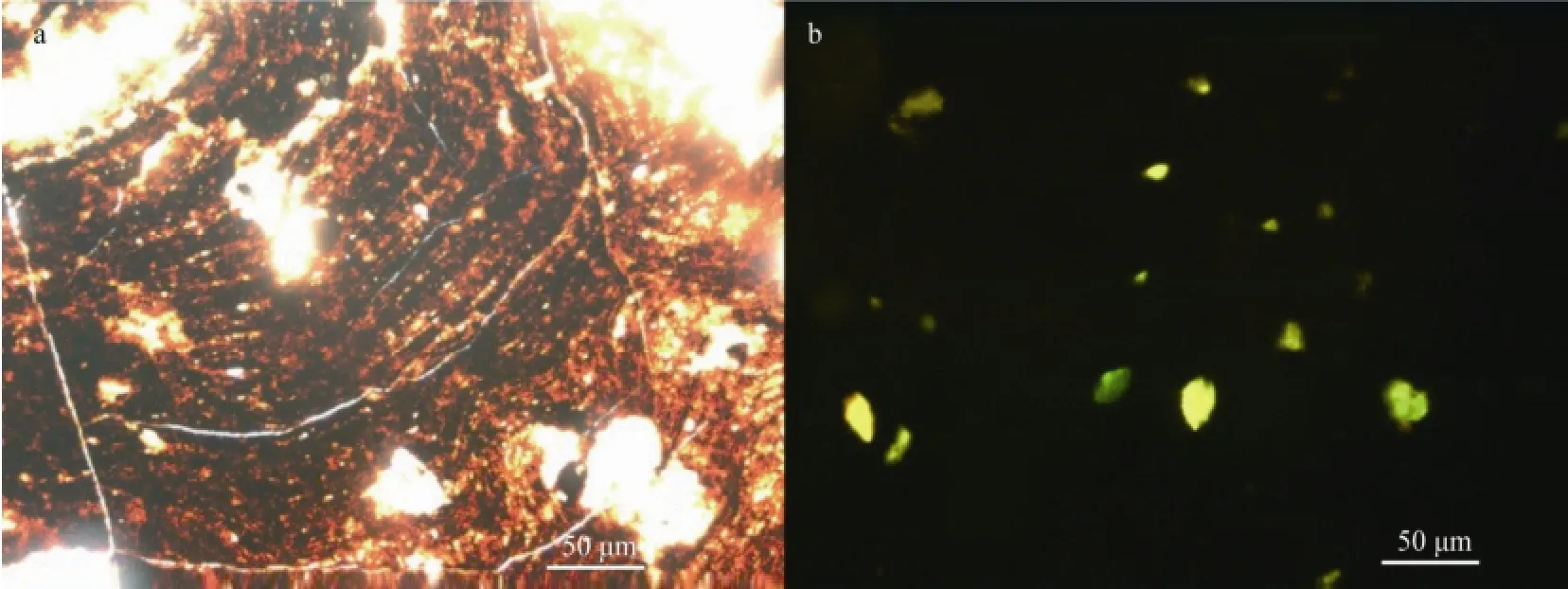
Fig.5 The Fe-Mn crust of lamellar structure and the hydrocarbon present in crusts shown by the fluorescence. Left:Columnar laminated texture within the lamellar Fe-Mn crust, 10×20(-); Right: Fluorescence of hydrocarbons present. Both panels show the same field of view. Sample number: CXD08.
4.6 Chemical Composition
4.6.1 Major and trace elements
All rock chemical analyses of representative samples from the CL, CA, CX seamounts and the Magellan seamount show a high loss on ignition (35.5%-40.2%). After the loss on ignition is deducted, the recalculated results of major element abundance in Fe-Mn crusts are obtained (Table 4). Fe and Mn are the major chemical components in Fe-Mn oxyhydroxide crusts. Although the Fe and Mn content of the crusts varies in different seamounts, Fe and Mn of hydrogenous crusts exhibit a narrow range of values (Banakaret al., 1997; Wenet al., 1997), and Fe and Mn of hydrothermal crusts have a wide range of values (Millset al., 2001). The Fe and Mn content ranges from 25.86%-31.11%, and the content of Fe (13.85%-18.45%) is higher than that of Mn (10.55%-13.77%) in all samples (Table 4). The small range of Fe and Mn suggests that the samples come from the hydrogenous crusts.
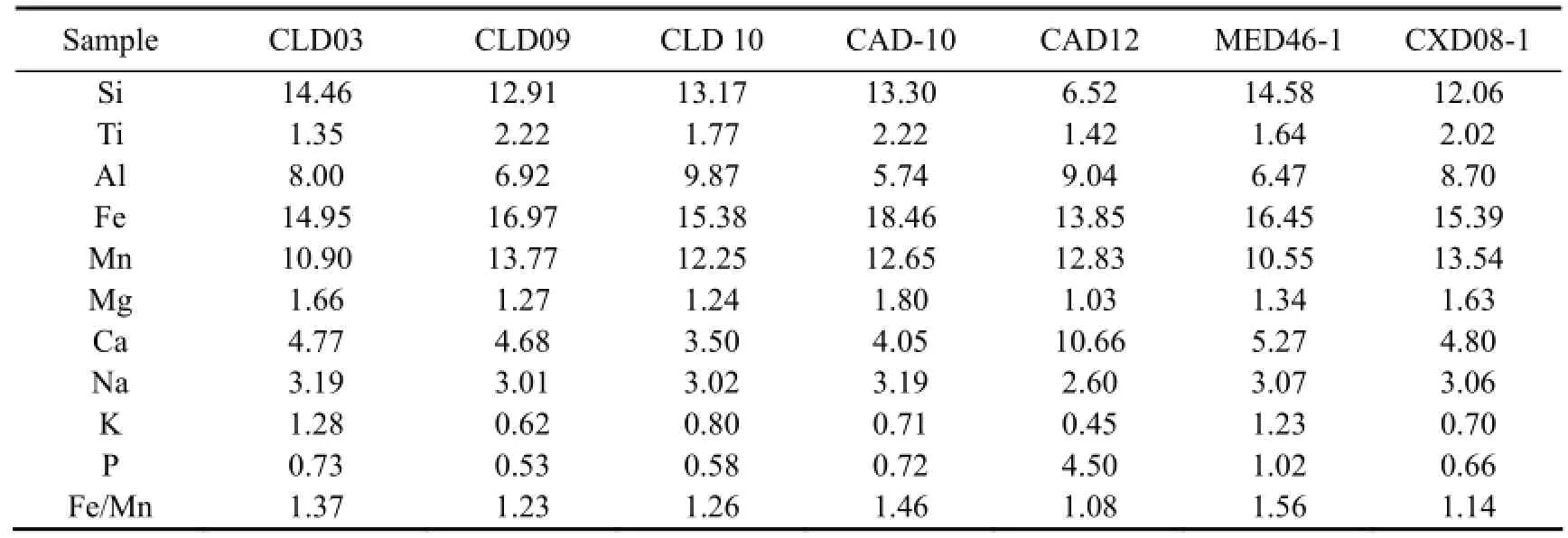
Table 4 Content of major elements in Fe-Mn crusts (Wt.%)
The hydrogenous crust tends to exhibit a more consistent Fe/Mn ratio (about 0.72 for the Pacific Fe-Mn crust) (Heinet al., 1997), and the hydrothermal crust shows a wide range of Fe/Mn ratios (about 〈0.002 to 3930 for TAG hydrothermal field) (Millset al., 2001). The Fe/Mn ratio of Fe-Mn crusts in the study area ranges from 1.14 to 1.56, which is close to the composition of Fe-Mn crusts of hydrogenous origin from the Marshall Islands and the far South Pacific (Heinet al., 2000; Millset al., 2001). The rates of Co, Ni, and Cu are different in the crusts of various origins. Co, Ni, and Cu are more abundant in the crusts of hydrogenous origin than hydrothermal origin on which the elements are deposited along the mid-ocean ridges (Bonattiet al., 1972). All of the samples from the study area are plotted in the hydrogenous origin field in (Co+Ni+Cu)*10-Fe-Mn diagram (Fig.6). The relationship among Zn, Ni and Co in the crusts can distinguish the crusts of hydrogenous origin from the crusts of hydro-thermal origin (Choi and Hariya, 1992). All of the Fe-Mn crusts studied in this work are plotted in the hydrogenous origin field and far away from the area of hydrothermal origin crusts (Fig.7).

Fig.6 The Fe-Mn-(Cu+Co+Ni)×10 ternary diagram (after Bonattiet al., 1972) based on the Fe-Mn crust data in the study area.
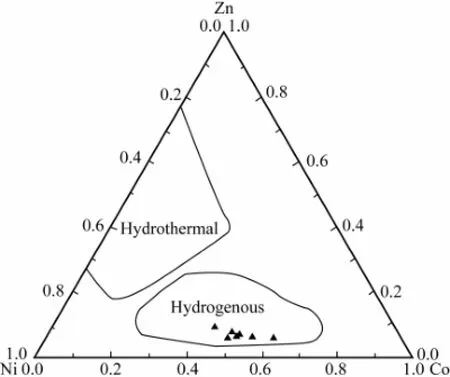
Fig.7 The Zn-Co-Ni diagram showing hydrothermal and hydrogenous deposition fields (after Choi and Hariya, 1992) based on the Fe-Mn crust data.
4.6.2 Rare earth elements
The rare earth element (REE) data collected from the studied area are listed in Table 5 and normalized to the chondrite values of Masuda (1975) in Fig.8. The Ce anomaly is defined as δCe=Cen/(Lan+Prn)/2, where the subscript n refers to the normalized chondrite values. Similarly, the Eu anomaly is defined as δEu=Eun/(Smn+Gdn)/2. Chemical analyses of the Fe-Mn crusts show high REE content with total amounts of 1408.16-1981.86 ppm (Table 5). The REE distribution patterns of all the analyzed samples are similar, with (La/Yb)nand ∑LREE/∑HREE being 7.16-8.56 and 8.44-11.60, respectively (Table 5). The analyses show that these crusts are enriched in LREE and depleted in HREE. The δCe and δEu are 1.65-2.55 and 0.68-0.75, with abnormally positive Ce, slightly positive Gd, and negative Eu (Fig.8). According to Elderfield (1988), the sign of the Ce anomaly in Fe-Mn crusts can be used to interpret the rate of crust growth and paleoenvironmental conditions. Hydrogenous crusts with positive Ce anomalies imply a very slow accumulation with a rate of less than 10 mm Ma (Kuhnet al., 1998).
Cerium is the only REE that may occur as a tetravalence in near surface environments. The contrasting charge and size of Ce4+compared to its trivalent REE neighbors lead to decoupling of Ce (IV) from other REEs (Heinet al., 2000; Astakhova and Sattarova, 2012). In marine environments, the Ce uptake by Mn and Fe oxy-hydroxides is accompanied by the Ce oxidation which is mediated by surface catalysis. The oxidative scavenging of Ce results in the preferential uptake and the development of positive Ce anomalies. Therefore, the Ce content in ocean water is unusually low (Bogdanovet al., 1995; Renet al., 2011).
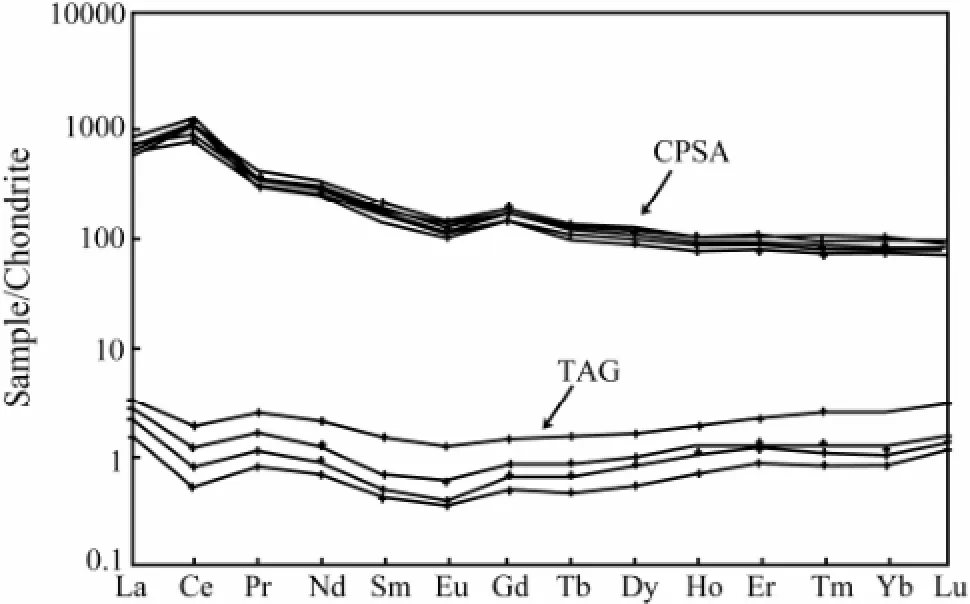
Fig.8 Chondrite normalized REE patterns for Fe-Mn crusts. CPSA: samples from the central Pacific seamount areas; TAG: samples from Trans-Atlantic Geotraverse (TAG) hydrothermal field, data from Millset al.(2001).
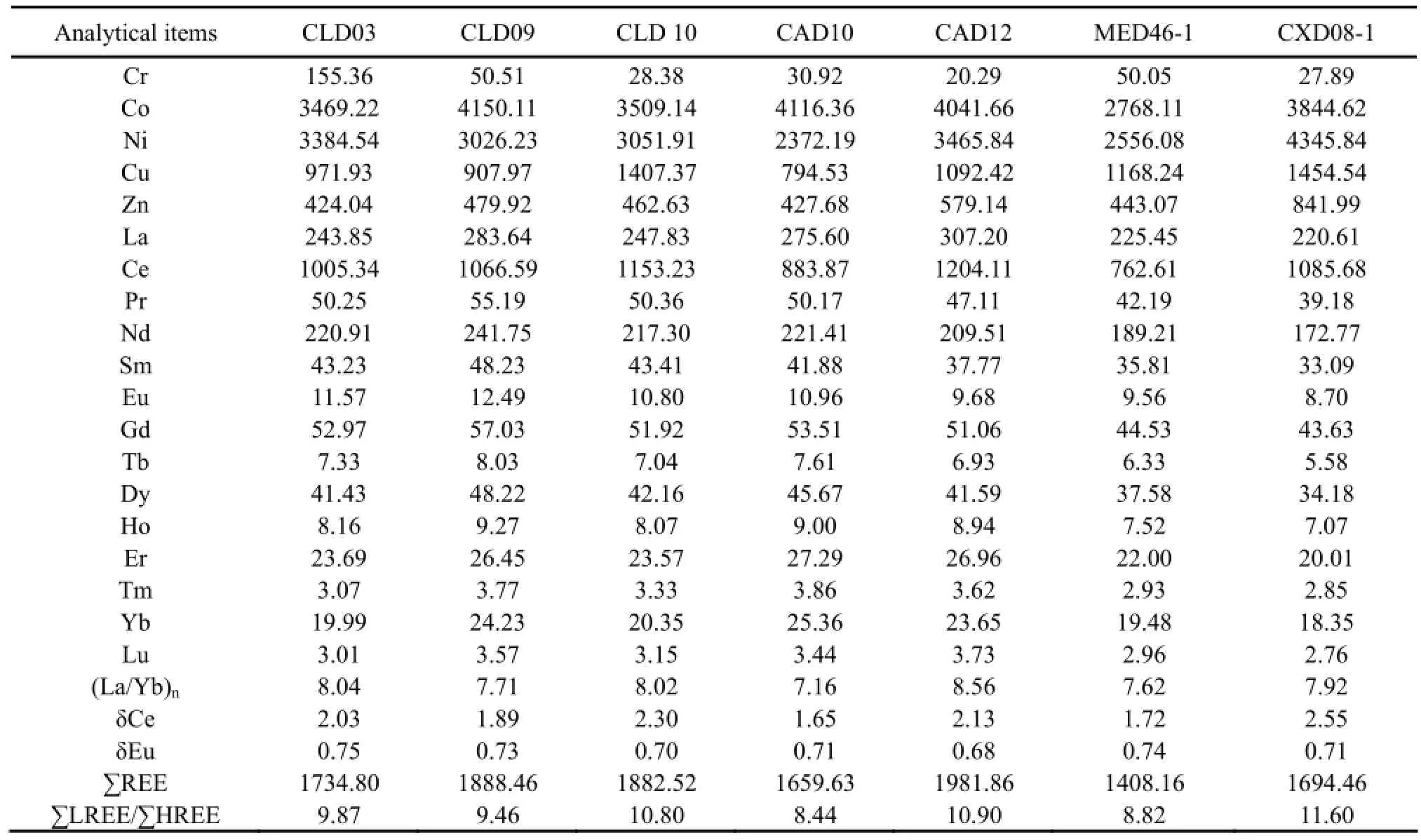
Table 5 Trace elements and REE data in the studied Fe-Mn crusts (ppm) and characteristic parameters
Anomalously positive Ce is frequently found in Fe-Mn nodules and crusts of hydrogenous origin (Heinet al., 1997; Bau, 1999; Logeset al., 2012). When Fe-Mn crusts in the study area are compared with those of typical hydrothermal origins, such as from the Trans-Atlantic Geotraverse (TAG) hydrothermal field, it is apparent that the ferromanganese crusts of hydrothermal origin have extremely low ∑REE (2.793-27.632 ppm) (Millset al., 2001) and negative Ce (Fig.8). The REE pattern of the studied Fe-Mn crusts is different from that of hydrothermal origins. This further supports the hydrogenous origin of Fe-Mn crusts in the western central Pacific by verifying a process that involves the precipitation of colloidal phases from sea water and the extensive scavenging of dissolved trace metals into the mineral phase during the crust formation.
5 Conclusions
1) Fe-Mn crust textures from the equatorial western Pacific Ocean, such as digitate, knobby, laminar, concentric ring, and half concentric ring, are similar to those constructed by bacteria and algae. Fe, Mn, and Ni in these crusts are characterized by banded, concentric ring, and half concentric ring distributions, and the composition ring belts and thicknesses overlap with textured laminae and ring belts.
2) Trace amounts of immature and low mature hydrocarbons are found in some of the Fe-Mn crusts. The hydrocarbons are randomly distributed in various crust textures and are not correlated with the composition distributions of Fe, Mn or Ni. The biomarker analyses show that the parental sources of hydrocarbons are mainly algae and bacteria or nonphotosynthetic bacteria living on the ocean floor. All of the evidence suggests that the precipitation, accumulation and distribution of elements, such as Fe, Mn, Ni and Co, in Fe-Mn crusts are not controlled by microbial activity and that algae and bacteria are incorporated into the crusts as dead organisms settling on the surface of the crusts without being swept away by currents.
3) A hydrogenous origin of Fe-Mn crusts is demonstrated in the equatorial western Pacific by a narrow range of Fe and Mn, a low ratio of Mn/Fe (0.64-0.88), an inverse correlation between Fe and Mn, exceptionally rich Co, Ni and Cu, abnormally positive Ce, apparently different contents of REE, and a distribution pattern distinct from the crusts of hydrothermal origin. High positive Ce anomaly further documents very slow oxyhydroxide precipitation.
4) The analyzed results support the preferred model for the Fe-Mn crust formation by the precipitation of colloidal phases from sea-water and the extensive scavenging of dissolved trace minerals into the mineral phase during the crust formation (Koschinsky and Halbach, 1995).
Acknowledgements
This study was supported by the National Natural Science Foundation of China (Grant No. 41273060). The authors acknowledge constructive comments by anonymous reviewers.
Astakhova, N. V., and Sattarova ,V. V., 2012. The REE species and their distribution in ferromanganese crusts in the Sea of Japan.Russian Geology and Geophysics, 53 (7): 649-656.
Banakar, V. K., Pattan, J. N., and Mudholkar, A. V., 1997. Palaeoceanographic conditions during the formation of a ferromanganese crust from the Afanasiy-Nikitin seamount, north central Indian ocean: Geochemical evidence.Marine Geology, 136: 299-315.
Bau, M., 1999. Scavenging of dissolved yttrium and rare earths by precipitating iron oxyhydroxide: Experimental evidence for Ce oxidation, Y-Ho fractionation, and lanthanide tetrad effect.Geochimica et Cosmochimica Acta, 63: 67-77.
Bian, L. C., Lin, C. Y., Zhang, F. S., Du, D. A., Chen, J. L., and Shen, H. D., 1996. Pelagic manganese nodules-A new type of oncolite.Acta Geologica Sinica, 70 (3): 232-236 (in Chinese with English Abstract).
(2)经济发展水平。人均GDP和固定资产投资与旅游经济网络之间具有正向相关性,说明较强的旅游经济联系往往会出现在居民生活水平较高、经济发达的地区,区域整体经济实力的提升对增强旅游经济联系具有积极促进的作用。但是随着旅游经济联系网络的完善,固定资产投资的影响力在逐渐降低。可能是由于固定资产在投资时更多以行政区划政府为主导,没有形成河南省全域化的整体意识,在一定程度上阻碍了旅游经济的交流。
Bird, C. W., Lynch, J. M., Pirt, F. J., Reid, W. W., Brooks, C. J. W., and Middleditch, B. S., 1971. Steroids and squalene inMethylococcus capsulatusgrown on methane.Nature, 230:473.
Blanckenburg, F. V., O’Nions, R. K., Belshaw, N. S., Gibb, A., and Hein, J. R., 1996. Global distribution of beryllium isotopes in deep ocean water as derived from Fe-Mn crusts.Earth and Planetary Science Letters, 141: 213-226.
Bogdanov, Y. A., Bogdanova, O. Y., Dubinin, A. V., Gorand, A., Gorshkov, A. I., Gurvich, E. G., Isaaeva, A. B., Ivanov, G. V., Jansa, L. F., and Monaco, A., 1995. Composition of ferromanganese crusts and nodules at northwestern Pacific guyots and geologic and paleoceanographic considerations. In:Proceedings of the Ocean Drilling Program.Texas A & M University, Ocean Drilling Program, College Station, USA, 144: 745-768.
Bonatti, E., Kraemer, T., and Rydell, H. S., 1972. Classification and genesis of iron-manganese deposits. In:Ferromanganese Deposits on the Ocean Floor.Horn, D. R., ed., National Science Foundation, Washington D.C., 149-166.
Chen, J. L., Zhang, F. S., and Bian, L. C., 1997. Ultra-microbes are the constructor of multimetallic nodules at the ocean floor.Chinese Science Bulletin, 42 (4): 337-342 (in Chinese ).
Choi, J. H., and Hariya, Y., 1992. Geochemistry and depositional environment of Mn oxide deposits in Tokoro belt, northeastern Hokkaido.Japan Economic Geology, 87: 1265-1274.
Clark, R. C., and Blumer, M., 1967. Distribution of n-paraffine in marine organisms and sediment.Limnology and Oceanography, 12: 79-87.
Cui, Y. C., Shi, X. F., Liu, J. H., Ren, X. W., Yin, J. W., and Hao, J. H., 2008. Discussion on the formation mechanism of columnar structure of cobalt-rich crusts.Acta Oceanologica Sinica, 30 (1): 74-79 (in Chinese with English abstract).
Elderfield, H., 1988. The oceanic chemistry of the rare-earth elements (in tracers in the ocean).Philosophical Transactions of the Royal Society of London, Series A: Mathematical and Physical Sciences, 325: 105-124.
González , F. J., Somoza, L., León, R., Medialdea, T., Torres, T., Ortiz, J. E., Lunar, R., Frías, J. M., and Merinero, R., 2012. Ferromanganese nodules and micro-hardgrounds associated with the Cadiz Contourite Channel (NE Atlantic): Palaeoenvironmental records of fluid venting and bottom currents.Chemical Geology, 310-311: 56-78.
Halbach, P., 1986. Processes controlling the heavy metal distribution in Pacific ferromanganese nodules and crusts.Geologische Rundschau, 75: 235-247.
Han, X. Q., Shen, H. T., Chen, J. L., Qin, J. C., Zhang, F. S., Lin, C. Y., and Bian, L. Z., 1997. Biogenesis and binary mineralization of organism and chemismus of polymetallic nodules from Pacific Ocean.Science in China (Series D), 40 (6): 656-661.
Hein, J. R., Koschinsky, A., and Halliday, A., 2003. Global occurrence of tellurium-rich ferromanganese crusts and a model for the enrichment of tellurium.Geochimica et Cosmochimica Acta, 67 (6): 1117-1127.
Hein, J. R., Koschinsky, A., Bau, M., Manheim, F. T., Kang, J. K., and Roberts, L., 2000. Cobalt-rich ferromanganese crusts in the Pacific. In:Handbook of Marine Mineral Deposits, Cronan. CRC Press, Boca Raton, FL, USA, 239-279.
Hein, J. R., Koschinsky, A., Halbach, P., Manheim, F. T., Bau, M., Kang, J. K., and Lubick, N., 1997. Iron and manganese oxide mineralization in the Pacific. In:Manganese Mineralization: Geochemistry and Mineralogy of Terrestrial and Marine Deposits. Nicholson, K.,et al., eds., Geological Society Specical Publication, 119: 123-138.
Hu, W. X., Jin, Z. J., Yao, S. P., Lu, X. C., Zhang, L. Y., Chen, Z. L., Zhang, X. J., and Zhou, H. Y., 2002. Discovery of lowmature hydrocarbon in manganese nodules and ooze from the central Pacific deep sea floor.Chinese Science Bulletin, 47 (11): 939-944.
Hu, W. X., Zhou, H. Y., Gu, L. X., Zhang, W. L., Lu, X. C., Fu, Q., Ran, J. M., and Zhang, H. S., 2000. New evidence of microbe origin for ferromanganese nodules from the East Pacific deep sea floor.Science in China (Series D), 43 (2):187-192.
Jansa, L. F., Pratt, B. R., and Dromart, G., 1989. Deep water thrombolite mounds from the Upper Jurassic of offshore Nova Scotia. In:Reefs-Canada and Adjacent Area.Geldsetzer, H. H.,et al., eds., Canadian Society of Petroleum Geology Memoir, 13: 725-735.
Klemm, V., Levasseur, S., Frank, M., Hein, J. R., and Halliday, A. N., 2005. Osmium isotope stratigraphy of a marine ferromanganeses crust.Earth and Planetary Science Letters, 238:42-48.
Koschinsky, A., and Halbach, P., 1995. Sequential leaching of marine ferromanganese precipitates: Genetic implications.Geochimica et Cosmochimica Acta, 59: 5113-5132.
Kuhn, T., Bau, M., Blum, N., and Halbach, P., 1998. Origin of negative Ce anomalies in mixed hydrothermal-hydrogenic Fe-Mn crusts from the Central Indian ridge.Earth and Planetary Science Letters, 163: 207-220.
Lin, C. Y., Bian, L. C., Zhang, F. S., Zhou, L. F., Chen, J. L., and Shen, H. D., 1996. Classification of the microbes and study of beaded ultramicrofossils in palagic manganese nodules.Chinese Science Bulletin, 41 (16): 1364-1368.
Loges, A., Wagner, T., Barth, M., Bau, M., Göb, S., and Markl, G., 2012. Negative Ce anomalies in Mn oxides: The role of Ce4+mobility during water-mineral interaction.Geochimica et Cosmochimica Acta, 86 (1): 296-317.
Lozano, R. P., and Ross, C., 2012. Exceptional preservation of Mn-oxidizing microbes in cave stromatolites (El Soplao, Spain).Sedimentary Geology, 255-256: 42-55.
Ma, W. L., Jin, X. L., Chen, J. L., Su, X., and Zhang, W. Y., 2002. Geological characteristics of Co-rich crusts from the Mid-Pacific seamounts area.Donghai Marine Science, 20 (3):11-22 (in Chinese with English abstract).
Masuda, A., 1975. Abundances of monoisotopic REE, consistent with the Leedey chondrite values.Geochemical Journal, 9:183-184.
Mills, R. A., Wells, D. M., and Roberts, S., 2001. Genesis of ferromanganese crusts from the TAG hydrothermal field.Chemical Geology, 176: 283-293.
Moldowan, J. M., Seifert, W. K., and Gallegos, E. J., 1985. Relationship between petroleum composition and depositional environment of petroleum source rocks.American Association of Petroleum Geologist Bulletin, 69: 1255-1268.
Murray, J. W., and Brewer, P. G., 1977. Mechanisms of removal of manganese, iron and other trace metals from sea water. In:Marine Manganese Deposits. Glasby, P. G., ed., Elsevier Oceanography Series, 15: 291-325.
Oda, H., Usui, A., Miyagi, I., Joshima, M., Weiss, B. P., Shantz, C., Fong, L. E., McBride., K. K., Harder, R., and Baudenbacher, F. J., 2011. Ultrafine-scale magnetostratigraphy of marine ferromanganese crust. Geology, 39 (3): 227-230.
Peters, K. E., and Moldowan, J. M., 1995.The Biomarker Guide: Interpreting Molecular Fossils in Petroleum and Ancient Sediments. Petroleum Industry Press, Beijing, 156-175.
Polgári, M., Hein, J. R., Vigh, T., Szabó-Drubina, M., Fórizs, I., Bíró, L. A., Müller, A., and Tóth, A. L., 2012. Microbial processes and the origin of the Úrkút manganese deposit, Hungary.Ore Geology Reviews, 47: 87-109.
Quinby-Hunt, M. S., and Turekian, K. K., 1983. Distribution of elements in sea water.Eos, Transactions, American Geophysical Union, 64 (14): 130-131.
Rehkämper, M., Frank, M., Hein, J. R., and Halliday, A., 2004. Cenozoic marine geochemistry of thallium deduced from isotopic studies of ferromanganese crusts and pelagic sediments.Earth and Planetary Science Letters, 219: 77-91.
Rehkämper, M., Frank, M., Hein, J. R., Porcelli, D., Halliday, A., Ingri, J., and Liebetrau, V., 2002. Thallium isotope variations in seawater and hydrogenetic, diagenetic, and hydrothermal ferromanganese deposits.Earth and Planetary Science Letters, 197: 65-81.
Ren, X. W., Liu, J. H, Shi, X. F., and Yin, J. W., 2011. Geochemistry of a marker of younger deposit of co-rich ferromanganese crust from Line Islands.Marine Geology & Quaternary Geology, 31 (3): 41-46.
Tissot, B. P., and Welte, D. H., 1984.Petroleum Formation and Occurrence. Springer-Verlag, New York, 699pp.
Volkman, J. K., Banks, M. R., Denwer, K., and Aquino Neto, F. R., 1989. Biomarker composition and depositional setting Tasmanite oil shale from northern Tasmania, Australia.14th International Meeting on Organic Geochemistry. Paris, Abstract No.168.
Wang, S., Schlossmacher, U., Natalio, F., Schroder, H. C., Wolf, S. E., Tremel, W., and Muller, W. E. G., 2009. Evidence for biogenic processes during formation of ferromanganese crustsfrom the Pacific Ocean: Implications of biologically induced mineralization.Micron, 40: 526-535.
Wang, X., and Muller, W. E. G., 2009. Marine biominerals:Perspectives and challenges for polymetallic nodules and crusts.Trends in Biotechnology, 27: 375-383.
Watkins, D. K., Premoli Silva, I., and Erba, E., 1995a. Cretaceous and Paleogene manganese-encrusted hardgrounds from central Pacific guyots.Proceedings of the Ocean Drilling Program, Scientific Results. College Station, TX, 144: 97-126.
Watkins, R. T., Nathan, Y., and Bremner, J. M., 1995b. Rare earth elements in phosphorite and associated sediment from the Namibian and south African continental shelves.Marine Geology, 129: 111-128.
Wen, X., De Carlo, E. H., and Li, Y. H., 1997. Interelement relationships in ferromanganese crust from the central Pacific ocean: Their implications for crust genesis.Marine Geology, 136: 277-297.
Wolff, G. A., Lamb, N. A., and Maxwell, J. R., 1986. The origin and fate of 4-methyl steroid hydrocarbons I: 4-methyl sterenes.Geochimica et Cosmochimica Acta, 50: 335-342.
Wu, G. H., Pulyaeva, I. A., Liu, J. H., and Li, X. F., 2011. Biostratigraphic research on the seamount ferromanganese crusts of mid-Pacific ocean.Acta Oceanologica Sinica, 33 (4):129-139.
Yu, S. Y., 1988.Fossil Carbonate Mic-Face. Geological Publishing House, Beijing, 49-57 (in Chinese).
Zhang, F. S., Bian, L. Z., Lin, C. Y., Zhou, L. F., Du, D. A., Chen, J. L., Shen, H. D., and Han, X. Q., 1995. Discovery of the spiral ultra-microfossils in pelagic manganese nodules and their significance.Geological Journal of University, 1 (1):109-117 (in Chinese with English abstract).
Zhao, J. R., Chu, F. Y., Yang, K. H., Lei, J. J, and Jin, L., 2009. Manganese mineral components, compositional characteristics and their implication for genesis of cobalt-rich crust from C seamount in Central Pacific.Journal of Marine Sciences, 27 (1): 15-21 (in Chinese with English abstract).
Zhu, K. C., Zhao, Z. B., and Li, Y., 2001. Cobalt-rich ferromanganese crusts from the MA, ME and MF seamounts of the Magellan Seamounts.Marine Geology & Quaternary Geology, 21 (1): 33-38 (in Chinese with English abstract).
(Edited by Xie Jun)
(Received May 7, 2013; revised September 12, 2013; accepted December 11, 2014)
© Ocean University of China, Science Press and Springer-Verlag Berlin Heidelberg 2015
* Corresponding author. E-mail: wangguozhi66@163.com
猜你喜欢
杂志排行
Journal of Ocean University of China的其它文章
- Impacts of the Two Types of El Niño on Pacific Tropical Cyclone Activity
- Numerical Simulation of Typhoon Muifa (2011) Using a Coupled Ocean-Atmosphere-Wave-Sediment Transport (COAWST) Modeling System
- Estimating the Turbulence Characteristics in the Bottom Boundary Layer of Monterey Canyon
- Hydroelastic Analysis of a Very Large Floating Structure Edged with a Pair of Submerged Horizontal Plates
- A Storm Surge Intensity Classification Based on Extreme Water Level and Concomitant Wave Height
- Synergetic Analysis and Possible Control of Vortex-Induced Vibrations in a Fluid-Conveying Steel Catenary Riser
